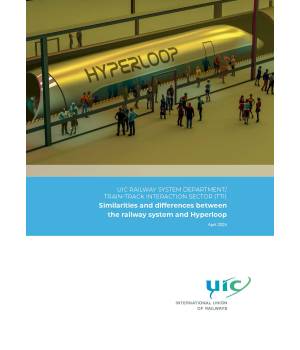
Similarities and differences between the railway system and Hyperloop
Recently, we have been witnessing the emergence of a new technology, which was largely unknown to most of us until a short while ago, Hyperloop.
Various assumptions and predictions have been made about this revolutionary mode of transport, with some experts stating that the Hyperloop will be valid for freight, but not for passenger transport. However, in countries like the United States, where high-speed rail has not been as largely deployed as in Europe, the Hyperloop has an obvious appeal.
Therefore, this document will start with a state of the art, which will act as an introduction to Hyperloop technology, describe its current state of development, and the strategic investment initiatives that Hyperloop is receiving from businesses and official bodies. The first part of the project will end with a SWOT Matrix, providing a deeper understanding of all Hyperloop dimensions in a visual and interactive way.
Within the railway system, and especially inside official bodies, such as the International Union for Railways (UIC), joint working groups have been created between railway and Hyperloop. The aim of these groups is to find the potential synergies and differences between the railway and Hyperloop as a mode of transport.
The second part of the document will consist of a comparative analysis between the railway system and Hyperloop, and will discuss two essential aspects in the life cycle of any transport system: planning and operation.
It should be noted that the project does not pretend to provide detailed analysis of every aspect of the Hyperloop or railway systems. Instead, the aim of the project is to perform holistic analysis, with the objective of studying railway and Hyperloop as transport systems in which similarities, differences and synergies can occur in the future.
Practical examples will be given after the comparative analysis. This will consist of a Multi-Criteria Decision Analysis (MCDA) carried out for the following alternatives:
- Construction of a high-speed rail line in the Northeast corridor
- Construction of an Hyperloop line for passenger transport in the Northeast corridor of the United States
The objective of the practical examples is to continue on from the comparative analysis, and to obtain the maximum possible number of similarities and differences between the railway system and Hyperloop. Thereby analysing and comparing aspects which may have not been detailed in the two first parts of the document.
The practical application’s conclusions will equip the reader with additional tools to assess and obtain more facts on the potential similarities and differences between railway system and Hyperloop in terms of, for example, energy consumption, infrastructure costs, operational revenue, or noise production.
Finally, the main (tentative) conclusions of the project will be outlined and oriented primarily, but not exclusively, towards the following questions:
- How can the railway system contribute to the improvement of Hyperloop?
- What aspects of Hyperloop could the railway system incorporate?
| Author | UIC |
| ISBN | 978-2-7461-3382-2 |
| Pages | 56 |
Data sheet
- Language
- English
- Format
- Downloadable
- Edition
- Ed. no.1
- Edition date
- 01/04/2024
- Publication date
- 30/04/2024
- Page number
- 56
- Theme
- Technology Technologie Train track interaction Interaction train/voie
- sku
- 5-24002E-PDF
- Reference
- 5-24002E
 Cookie preferences
Cookie preferences

